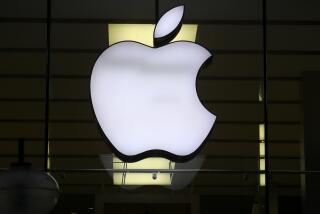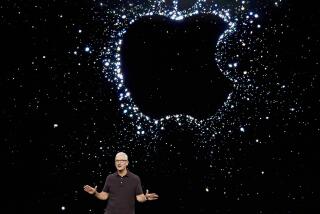Apple to offer 99-cent TV show rentals on revamped box
Reporting from San Francisco and Los Angeles — Apple is taking a bite out of online TV rental prices, in part to try to revive its Apple TV product that never caught on with consumers.
The computer maker, which revolutionized the music industry nine years ago with its iPod and online iTunes store, said Wednesday it would offer TV show rentals for 99 cents online, down from as much as $2.99.
Initially, only shows produced by Walt Disney Co.’s ABC Television Group, such as “ Desperate Housewives,” and News Corp.’s Fox Filmed Entertainment, such as “Glee,” will be available at the bargain price. Also, BBC America will have its shows on the plan.
The majority of Hollywood studios and two broadcast networks — CBS and NBC — declined to allow their shows to be included.
Apple Chief Executive Steve Jobs, who announced the new service and upgrades of several company products at an event in San Francisco on Wednesday, acknowledged that many providers were not aboard.
“Not all of them wanted to take this step with us,” Jobs said. “We think the other studios will see the light.”
That light could be at the end of a very long tunnel, some analysts said.
“We believe it would be shortsighted for the studios to devalue their product and enhance Apple’s power over the electronic distribution of their content,” Alan Gould, an analyst with Evercore Partners, wrote in a note to investors.
Television producers, who spoke on condition of anonymity for fear of antagonizing a powerful distributor like Apple, say the new rental model would threaten the economics that underwrite the cost of creating expensive television shows. Some are concerned that giving consumers a cheap way to rent commercial-free episodes of a show such as CBS’ “CSI: Miami” would undermine DVD sales, because it would cost less than $24 to watch an entire season. The DVD set, by contrast, sells for more than $50.
Other producers worry that 99-cent TV show rentals would split up lucrative season-long bundles of TV show. It’s far more lucrative for TV producers to sell 100 episodes of a show into syndication, as Warner Bros. did in a $25-million deal that gave streaming rights for all 100 episodes of “Nip/Tuck” to Netflix.
The 99-cent a la carte offerings might have trouble catching on with consumers. Most TV shows available online now are free, and others are available under all-you-can-eat subscription plans from Netflix.
Media analyst Paul Verna of researcher EMarketer said Apple is missing the mark when it comes to TV shows. Unlike movies, consumers aren’t in the habit of renting TV shows.
“I think a lot of people would rather watch for free on Hulu, or even pay the subscription on Hulu, but have this illusion of getting it for free, rather than pay a la carte,” Verna said.
It might be even tougher to get the public behind the Apple TV device, introduced four years ago to deliver online programming to television sets.
“It’s never been a huge hit,” Jobs said. The new version of the device shows programs in high-definition and has built-in Wi-Fi. The price is $99, down from $229 for the original. The new Apple TV will be available in about a month, Jobs said.
The device has an HDMI connector to hook it into a high-definition television. It has no storage; all offerings coming from iTunes will be delivered via the Internet.
But Apple’s move comes as more consumers are watching movies and television over broadband Internet lines rather than on traditional cable. That trend has pitted Silicon Valley companies such as Apple, Amazon.com and Netflix against cable providers in a struggle to control the way living room entertainment is delivered.
“People are just becoming more attuned to broadband media as opposed to broadcast,” said Jordan Selburn, an analyst at technology research firm ISuppli Corp. in El Segundo.
But Apple TV has ample competition. ISuppli said the market for Internet-connected living room devices — a category that includes not only set-top boxes like the Apple TV but also video game consoles and Web-ready TVs that can handle online video content — is growing faster than that for any other kind of Internet device, including computers.
By 2014, the company said, manufacturers will ship 450 million connected living room devices, more than four times the number shipped in 2009.
But getting online-connected devices doesn’t mean consumers will cancel their usual TV sources, at least right away.
“The bigger issue is whether people are willing to fundamentally cut the cord with their video content provider,” Selburn said. “We’re still a good ways away from boxes like this being able to completely supplant DirecTV, Comcast, etc.”
On the music side, Jobs introduced a social network feature, Ping, that will be added to iTunes to allow users to establish profiles, send messages and “follow” friends to see what music they’re listening to. “It’s a social network all about music,” Jobs said.
And he announced upgrades to several of the company’s iPod music players. Some have added features but nothing much brand new. For the most part the added features are already available on other Apple products. The upgraded models, which will be available next week:
• IPod Touch: This touch-screen music player — which also has Internet access to browse the Web and get apps for gaming and various tasks — will be getting a front-facing video camera to allow for live video chats. This service, which Apple calls Facetime, was introduced in June for the latest version of the iPhone. Video chats on the iPod Touch will be enabled only in Wi-Fi areas.
Also new on the Touch: a higher-resolution screen (the same one that’s on the latest iPhone) plus a rear-facing camera for photographs.
Prices will start at $229 for the 8GB storage model, topping out at $399 for the 64GB model.
• IPod Nano: This unit got the most radical makeover. Apple has done away with the traditional click wheel in favor of a touch screen on the player, which is nearly all-screen in appearance and square in shape. It will include a radio, but unlike the current Nano, it will not have a camera.
Prices start at $148 for the 8GB storage version.
• IPod Shuffle: The smallest iPod, with no screen, will again get buttons (the current model is buttonless) to make it easier to use.
Price: $49.
More to Read
The biggest entertainment stories
Get our big stories about Hollywood, film, television, music, arts, culture and more right in your inbox as soon as they publish.
You may occasionally receive promotional content from the Los Angeles Times.










